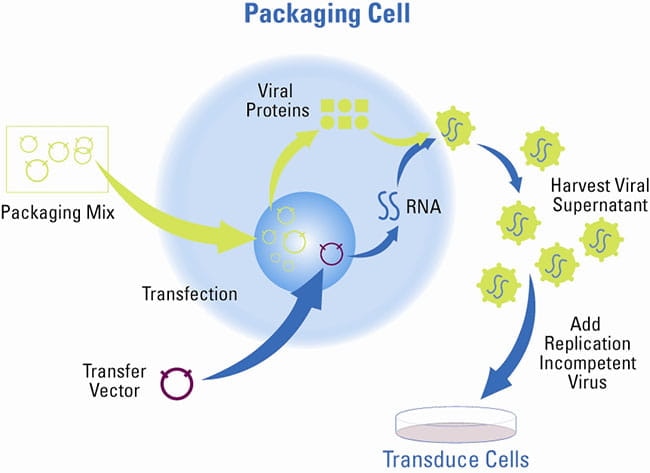- Gene modulation
- RNA interference
- Short hairpin RNA (shRNA)
- Trans-Lentiviral shRNA Packaging System
Trans-Lentiviral shRNA Packaging System
Package 2nd or 3rd generation viral vectors with high efficiency. Lentiviral packaging kits with calcium phosphate provide lower cost and higher-efficiency viral packaging along with premium biosafety.

The Trans-Lentiviral Packaging System utilizes the most advanced strategy for generating lentiviral particles for transduction of a gene or shRNA of interest. Co-transfection of the Trans-Lentiviral packaging plasmid mix and transfer vector into the packaging cell line, HEK293T, allows efficient production of lentiviral supernatant. Lentiviral particles can deliver genetic content into a wide range of cell types, including both dividing and non-dividing mammalian cells (see Figure 1, Supporting Data tab).
Highlights
- Consistent titers: 1 to 5 x 106 transducing units (TU) per mL are commonly achieved in collected supernatant
- Broad tropism: Effectively transduce most mammalian cell lines, including primary and non-dividing cells
- Patented technology: Contains all genetic elements necessary to package both second and third generation lentiviral vectors
Highest Level of Biosafety
- Five separate plasmids: Genes required for packaging the viral genome are separated onto five plasmids to minimize the threat of recombinant, replication-competent virus production
- Replication-incompetent: None of the structural genes are actually present in the packaged viral genome, therefore no new replication-competent virus can be produced
Product Formats
- With or without HEK293T cells
- Starter kits (10rxns) with an experimental control
- Bulk sizes (50, 100rxns) for large experiments
Trans-Lentiviral shRNA Packaging Kit Components
| Kit Contents | TLP5912 (10rxn) | TLP5917 (10rxn + cells) | TLP5913 (50rxn) | TLP5914 (100rxn) |
|---|---|---|---|---|
| Trans-Lentiviral Packaging Mix | 285µg | 285µg | 285µg x 5 | 285µg x 10 |
| HEK293T Packaging Cell Line | not included | 1.0mL | not included | not included |
| CaCl2 Reagent | 1.2mL | 1.2mL | 6mL | 6mL x 2 |
| 2X HBSS Reagent | 12.0mL | 12.0mL | 60mL | 60mL x 2 |
| pGIPZ Non-Silencing Control Vector DNA | 45 µg (0.45µg/µL) | 45µg (0.45µg/µL) | not included | not included |
Note: All plasmids are shipped on wet ice and stored at -20°C. For kits containing the packaging cell line, HEK293T, an additional dry ice cooler will be included in the shipment. Upon receipt, the cell line must be stored in liquid nitrogen for two days.
Trans-Lentiviral Packaging System

Figure 1. | Schematic showing production of lentiviral particles using the Trans-Lentiviral Packaging System
Functional Titers of GIPZ Lentiviral Vector Particles Generated Using CaPO4 and Arrest-In Transfection Reagents

Figure 2. | Lentiviral vector particles were produced from three different GIPZ clones using both the Arrest-In and Calcium Phosphate (CaPO4) transfection reagents. To generate the viral particles, HEK293T cells were co-transfected with the individual GIPZ constructs and the Trans-Lentiviral Vector packaging mix following recommended protocols. Culture supernatants containing the viral particles were collected approximately 64 hours post-transfection.
Supernatants were clarified by low-speed centrifugation, aliquoted, and stored at -80 �C. To determine functional titers, HEK293T cells were seeded in a 24-well plate and transduced the following day with a dilution series of each of the viral particles. At 72 hours post-transduction, the transduced cells (TurboGFP-positive) were counted under fluorescence microscopy and titers calculated as transducing units per milliliter (TU/ml). Results indicate that transfection using CaPO4 produced higher titers with all three GIPZ clones as compared to Arrest-In transfection.
Application notes
Product inserts
Safety data sheets
Related Products
Perform specific and efficient, transient or long-term RNAi with GIPZ Lentiviral shRNA. GIPZ Lentiviral shRNA targets human and mouse genes using multiple shRNA constructs that have been cloned into the pGIPZ lentiviral vector.
Study the function of essential genes, validate cellular phenotypes and generate inducible knockdown cell lines with TRIPZ Inducible Lentiviral shRNA.
The RNAi Consortium, or TRC, is a public-private effort based at the Broad whose mission is to create a shRNA library to enable the scientific community to use RNAi to determine the function of human and mouse genes.
